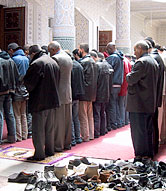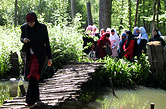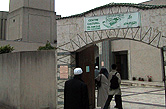How does a religious minority fit within secular France?
by Jocelyne Cesari
Since 1989, the appearance of the hijab (Muslim headscarf) in French public schools has opened the most impassioned debate over the role of laïcité (secularism) in French society since the separation of church and state in 1905. Conflicts between Muslim adolescents and school authorities have extended beyond the schools to involve intellectuals, political actors, and religious authorities, and, as of March 2004, a new law has been passed that bans all overt religious symbols from public schools.
The Conflicted Beginning of French Secularism
The term laïcité implies more than the legal separation of church and state; it is also a philosophy of public life and a fundamental principle of French culture. At the dawn of the twentieth century, when La Loi Sur La Laïcité, the law separating the French church and state, was born, legislators’ chief objective was not to regulate the domain of religion, but to sequester it. The Catholic Church dominated the French state before the revolution of 1789, and the Church opposed liberal values into the 20th century. Laïcité thus emerged as much from a desire to “undo” the religious sphere as to reconcile it with the public sphere.
Like in the United States, French secularism now involves the protection of religion from government interference, but unlike in the United States, secularism initially also meant the protection of the state from religious interference. The French political figures who established the laïcité law of 1905 were continuing the legacy of the Enlightenment, which held positivism — a belief in the power of secular humanism — as a central tenet. They followed a doctrine that confirms the triumph of the rational human being over the forces of religion, in which the state may function as a counter-model to religious faith. Laïcité, then, was seen as the means for cultivating a “new man” committed to reason, science, and progress.
Islam and French Secularism: The Roots of the Conflict
In this context, the national school system became an ideal forum in which to diminish the influence of the Catholic Church and to make clear the distinction between church and state. Today, it is difficult for French teachers to even talk about religion in state schools. The irony is that the laïcité law resulted from a conflict between the Republic and the Catholic Church, and yet its passage has not allowed France to officially erase its Catholic past. Seven of the country’s 11 national holidays coincide with Catholic celebrations — even as President Jacques Chirac has rejected a proposal to set aside one school holiday each for Jews and Muslims. And there are more inconsistencies. Private Catholic, Jewish, and Protestant schools receive state subsidies, and will be exempt under the new law regarding religious symbols. Currently, there is one private Muslim school, in Lille, that is hoping to obtain an exemption as well.
As the headscarf debate indicates, there exists an aversion to religious expression in France that is entirely unknown in the United States. Pluralism and competition between religions have marked American society since its origin. Religious differences were common among the first migrants to America, while the religious history of Europe has been dominated by the monopoly of one faith in each national context. As the United States grew, so did the diversity of its religious makeup, as Catholics and Jews and, more recently, Muslims and Buddhists have all found a place in American society. Migrants came to America to practice their religion unmolested, and the freedom of religious expression is a substantial part of the freedom of expression and individuality that are the hallmarks of American society. On the other hand, in France, religious expression is often seen as the cause of public and civic perturbations — something that needs to be regulated and controlled, rather than preserved or encouraged.
The Postcolonial Perception of Islam
The dominant perception of Muslims in France is based upon an inaccurate but still-lingering colonial image of a violent and static Islam. Negative associations with Islam, inspired by a tumultuous colonial history (particularly the war in Algeria) remain in the French collective memory. And the veil, in particular, is often perceived as an outdated symbol of female subjugation. The status of women in Islam appears to many as the antithesis of the principle of non-discrimination that governs relations between individuals in French society. Some go so far as to put the veil on par with the swastika as a divisive symbol.
France’s colonial history in Islamic countries, which has no real equivalent in American culture, exerts a strong influence on the French administration of Islam. French secularism does more than simply protect religious freedom or the political independence of religious organizations, as it does in the United States. So the secularization of Islam has involved adapting Muslim organizations to preexisting structures of Church-State relations. Since 1989, several Ministers of the Interior initiated a dialogue and rapprochement between leading branches of Islam and Islamic organizations. The successive negotiations led to the election in April 2003 of a representative body of Islam, Le Conseil Francais du Culte Musulman (CFCM), that has been recognized by the French State.
In the United States, Islam is merely a component of a diverse religious landscape. It is also the fastest growing religion in the country (the rate of conversion to Islam in the U.S. is extremely high in comparison to Europe). Half of the American Muslim community is composed of converts — primarily, but not exclusively, African Americans. This does not mean that Islam has been completely accepted into American society, especially after 9/11. But in the U.S., unlike France, there is a strong judicial tradition of defending religious freedom. Thus, the American judiciary can rule on cases of religious discrimination without creating a nationwide debate — which is why wearing the hijab isn’t a political issue in the U.S., even post-9/11.
Jocelyne Cesari is Senior Research Fellow at National Center for Scientific Research (CNRS), La Sorbonne, Paris and Visiting Professor at Harvard University. She is an expert on Muslim minorities in Europe and in the United States. Her most recent publication, published by Palgrave Press, is WHEN ISLAM AND DEMOCRACY MEET: MUSLIMS IN EUROPE AND IN THE UNITED STATES.



